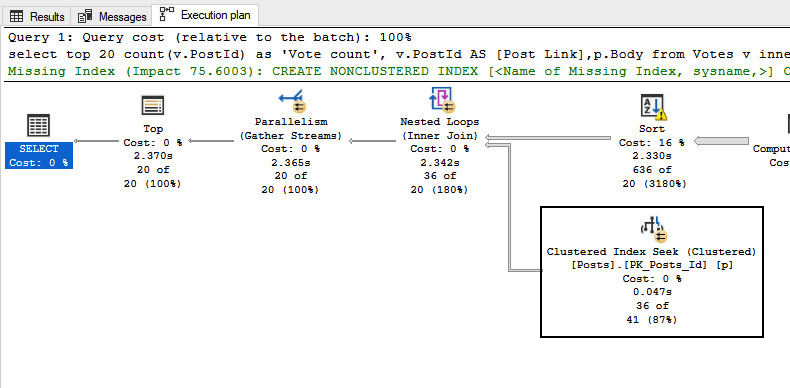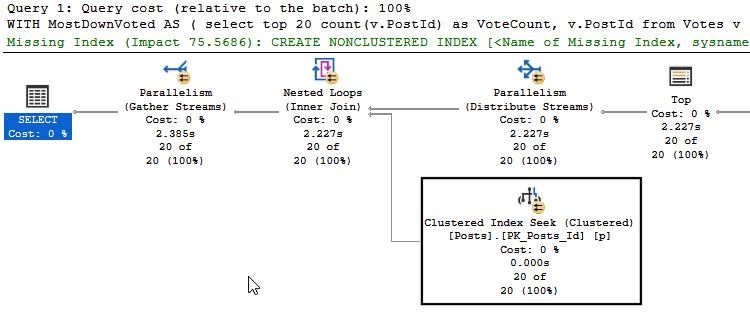
TIL: How to optimize Group by queries in SQL Server
07 Mar 2022 #todayilearned #sqlLet me share this technique I learned to improve queries with GROUP BY in SQL Server.
To improve queries with GROUP BY, write the SELECT query with the GROUP BY part using only the needed columns to do the grouping or sorting inside a common table expression (CTE) first. Then, join the CTE with the right tables to find other columns.
Usual GROUP BY: Find StackOverflow most down-voted questions
Let’s use this technique to tune the store procedure to find most down-voted questions on StackOverflow.
Here’s the store procedure. Let’s fire our local copy of the StackOverflow 2013 database to run it.
CREATE OR ALTER PROC dbo.MostDownVotedQuestions AS
BEGIN
select top 20 count(v.PostId) as 'Vote count', v.PostId AS [Post Link],p.Body
from Votes v
inner join Posts p on p.Id=v.PostId
where PostTypeId = 1 and v.VoteTypeId=3
group by v.PostId, p.Body
order by 'Vote count' desc
END
GO
I ran this stored procedure on my local machine five times without any indexes. It took about 2 seconds each time. On my machine, SQL Server only had 8GB of RAM. Remember, by default SQL Server uses all available RAM.
This is the execution plan. Let’s notice the Clustered Index Seek on the dbo.Posts table. And, yes, SQL Server is recommending an index. But we’re not adding it.

Then, these are the metrics grabbed with sp_BlitzCache from the First Responder Kit. This stored procedure finds all the most CPU intensive queries SQL Server has recently executed.

To find the most down-voted questions, our stored procedure is grouping by Body. And, that’s an NVARCHAR(MAX) column, the actual content of StackOverflow posts.
Sorting and grouping on large data types is a CPU expensive operation.

Group and order inside CTE’s first
To improve queries with GROUP BY, group inside a common table expression (CTE) with only the required columns in the grouping. For example, IDs or columns covered by indexes. Then, join the CTE with the right tables to find other columns.
After grouping only by PostId inside a CTE first, our stored procedure looks like this,
CREATE OR ALTER PROC dbo.MostDownVotedQuestions AS
BEGIN
WITH MostDownVoted AS (
select top 20 count(v.PostId) as VoteCount, v.PostId /* We removed the Body column */
from Votes v
inner join Posts p on p.Id=v.PostId
where PostTypeId = 1 and v.VoteTypeId=3
group by v.PostId /* Also, from here */
order by VoteCount desc
)
select VoteCount as 'Vote count', d.PostId AS [Post Link], p.Body
from MostDownVoted d
inner join Posts p on p.Id = d.PostId
END
GO
This time, we are excluding the Body column from the GROUP BY part. Then, we are joining the MostDownVotes CTE to the dbo.Post table to show only the Body of the 20 resulting posts.
Again, this is the execution plan of grouping inside a CTE first.

Notice the Clustered Index Seek operator on the left branch. That’s to find the body of only the 20 post SQL Server found as a result of grouping inside the CTE. This time, SQL Server is grouping and sorting fewer data. It made our stored procedure use less CPU time.
Let’s take another look at sp_BlitzCache. Before running the modified version of our store procedure five times, I ran DBCC FREEPROCCACHE to free up SQL Server’s plan cache.

Notice the “Total CPU” and “Avg CPU” columns, we’re using less CPU time after the change. I went from 36.151ms of total CPU time to 35.505ms. Hooray!
Now, imagine if that store procedure runs not only 5 times, but multiple times per minute. What if our stored procedure feeds a reporting screen in our app? That change with a CTE will make a huge difference in the overral CPU usage.
Voilà! That’s how we can improve queries with GROUP BY. Remember, group and sort inside CTE’s to take advantage of existing indexes and avoid expensive sorting operations. Use this technique with OFFSET/FETCH, SUM, AVG, and other group functions.
I learned this technique following Brent Ozar’s Mastering Query Tuning class.
For more SQL Server content, check don’t write functions around columns in WHERE, what are implicit conversions?, and How to do a case-sensitive search in SQL Server.
Happy coding!